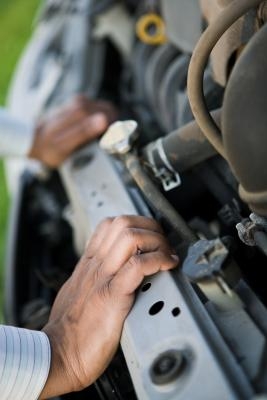
A radiator and cooling system are crucial to the operation and life of any car. If a radiator is leaking or otherwise malfunctioning, the car's engine will become damaged, leading to failure and expensive major repairs. All parts of the car's cooling system need to be checked regularly, including the water pump, belts, hoses and thermostat. The radiator should be tested periodically as well, particularly if the car begins to overheat or run hotter than normal.
Remove the lower hose from the radiator, making certain that the radiator is full of coolant. Start the engine and observe the flow of coolant as it pours out of the radiator. The coolant should actually flow hard enough to fill the radiator opening on its way out. If it does not, there is a flow problem inside the radiator.
Heat test the radiator with an infrared thermometer. An infrared thermometer has a lens that can measure temperature on a surface from a distance. The thermometer can scan the radiator's surface to find cold spots, which indicate possible clogs. If you do not have an infrared thermometer, you can also feel the radiator with your hand, once the radiator cools a bit, noting any changes in temperature from top to bottom. If the flow of coolant is sufficient, there should be less heat near the radiator outlet and more heat near the radiator inlet.
Test the radiator pressure. Remove the radiator cap and install a pressure tester, which looks like a blood pressure tester and has a pump. Pressure testers are included in most radiator test kits. Pump the tester and carefully observe the pressure gauge. The gauge should read a minimum of 15 pounds of pressure. If the pressure is below 15 pounds, the radiator probably has a leak.
Observe the radiator cap while the engine is running to see if any fluid is leaking around the perimeter of the radiator cap. Alternatively, observe the radiator cap when it is attached to the pressure tester. Even if the radiator is in good working order, an improperly fitting or leaking radiator cap will allow enough coolant to leak to create an overheating situation.
Use a test strip which measures the Ph of the coolant, if you have a diesel engine. These test strips are designed to measure the concentration of antifreeze coolant inhibitors, including nitrite, molybdate and glycol. However, these strips are only designed for diesel engines.